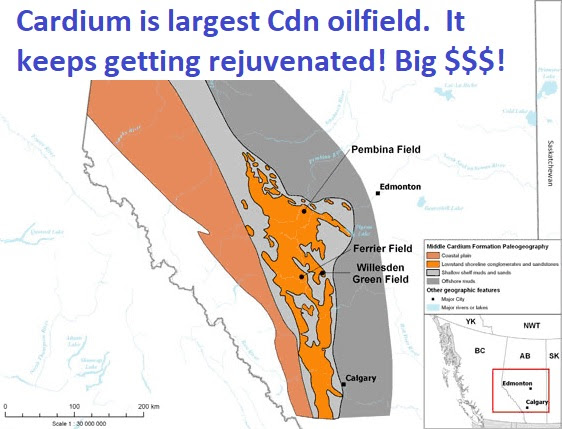Napoleon is credited with the saying—I would rather have my generals be lucky than good.
And that’s a good saying for Yangarra Resources (YGR-TSX), as they discovered how prolific the Lower Cardium, or “Bioturbated Zone” is in Alberta’s massive Cardium formation–all by accident.
They were drilling in the main Cardium zone above–which everyone agrees is more porous and therefore better rock–but their directional drill went too deep one time. Despite their best efforts, they could not get the drill back up into the main Cardium payzone they wanted.
So they fracked it anyway and WHOOSH! Up from the ground came a bubbling pool, as the TV song goes.
With higher pressures, better flow rates, and lower declines–Yangarra created a big improvement in the rate of return being earned from previous Cardium wells.
After a ten well drilling program targeting the Bioturbated, in June of this year Yangarra released type curve details for the play:
IP 30 Rates – 490 boe/d (80 percent oil)
IP 90 Rates – 425 boe/d (70 percent oil)
Twelve month declines – 48% on a boe basis
At US$47.50/bbl WTI pricing, Yangarra’s type curve generates a half cycle internal rate of return of 132% and suggests the wells have a payout of 10 months.
That would make those wells every bit as good as the very best parts of the Permian Basin where land prices have hit $50,000 per acre.
CEO Jim Evaskevich laughs…”Yes we got lucky but at least we knew what to do with it when we found it.”
Well, that well has (once again) rejuvenated the huge Cardium formation–the largest bearing oil formation in Canada, with over 10 billion barrels of Original Oil In Place (OOIP) and it has produced over 1.6 billion barrels in its history.
Yangarra’s success–the stock has gone from 4o cents to $3.75 in 18 months–has spurred many different junior producers to drill their horizontal legs a little deeper in the Cardium, and has (the few remaining) energy investors searching for who else could drill this slightly deeper formation.
The reason that Willesden Green and Ferrier Cardium operators had not intentionally targeted the Bioturbated Zone previously is that it is a siltstone that wasn’t thought to be favorable for fracking.
What Yangarra discovered is that the Bioturbated Zone–is extremely brittle (or at least that is the theory) and with enough pressure will crack.
Since that first surprisingly successful well Yangarra has been continuing to experiment with the best way to attack the Bioturbated.
The first few Bioturbated wells had roughly 70 frack stages and 1,000 tons of sand. The most recent wells drilled this August are two mile laterals with over 130 frack stages and 3,000 tons of sand.
The company has yet to hit the optimal well design and until the well results stop getting better you can expect them to keep pushing forward with more frack stages and more sand.
The Bioturbated In The Cardium – Everyone Is Doing It
Yangarra had been operating in the Cardium for seven years and hadn’t tried drilling a well into the Bioturbated.
The company …read more
Source:: Keith Schaefer
The post New Oil Zones in Canada Still Being Discovered–And They Pay Back FAST! appeared first on Junior Mining Analyst.

